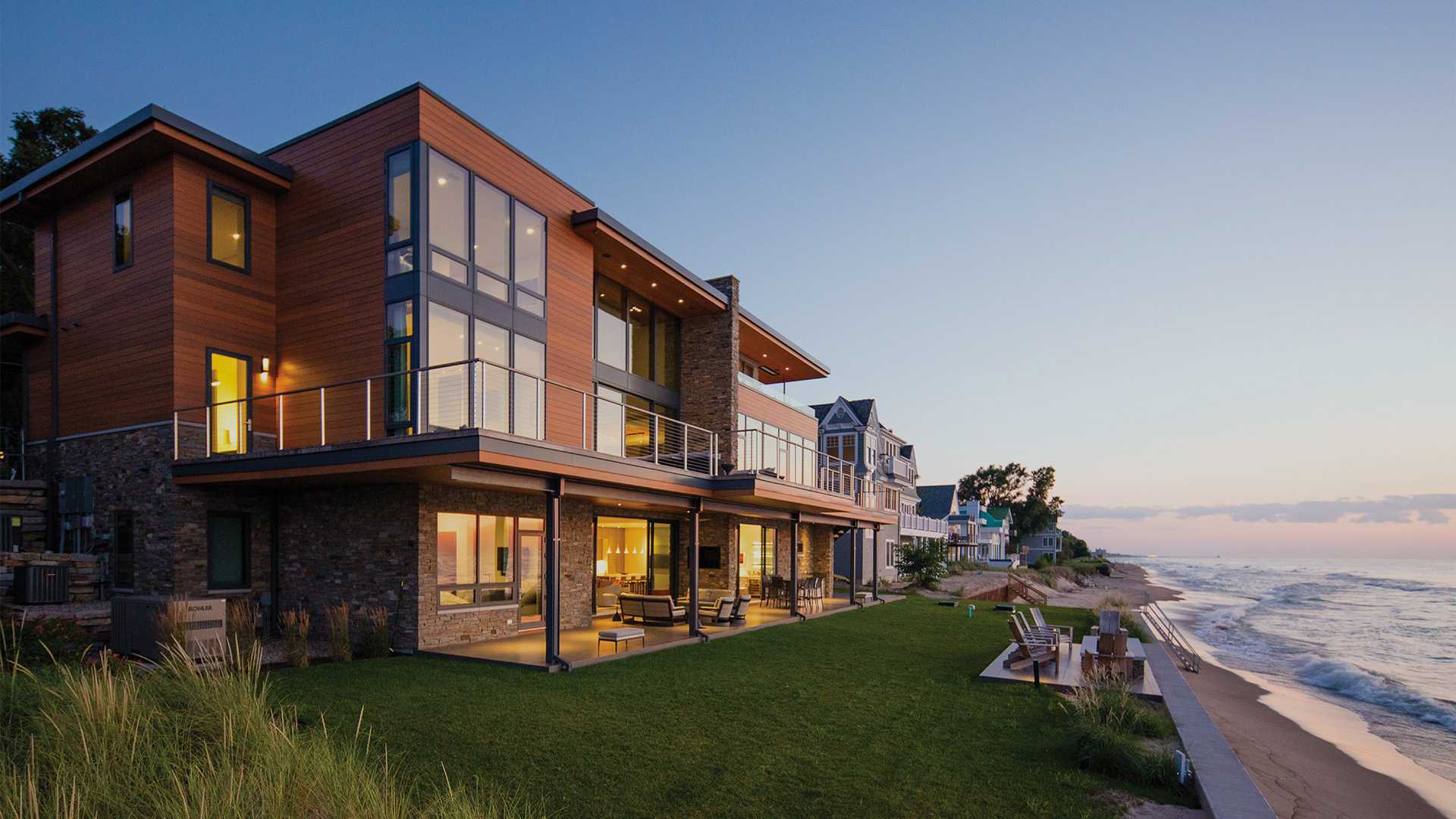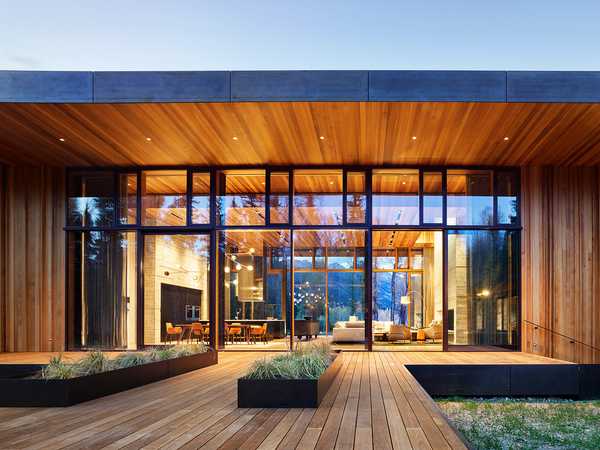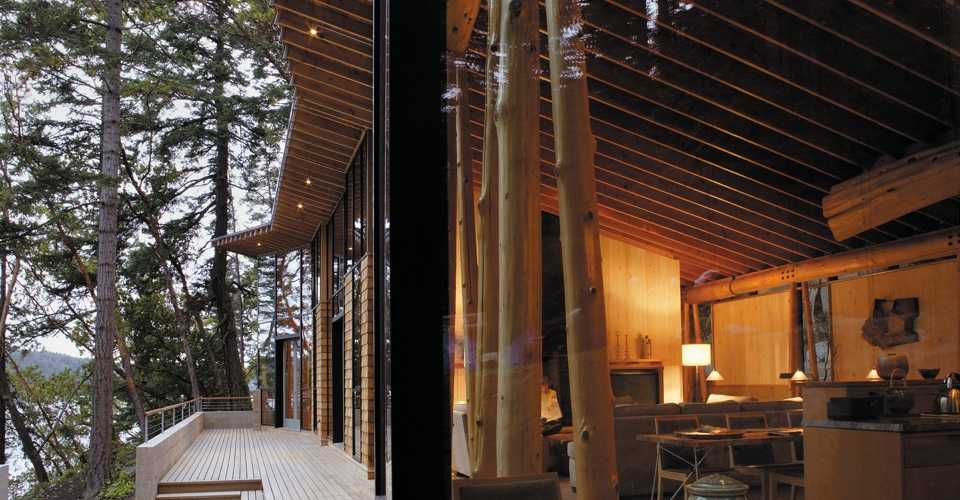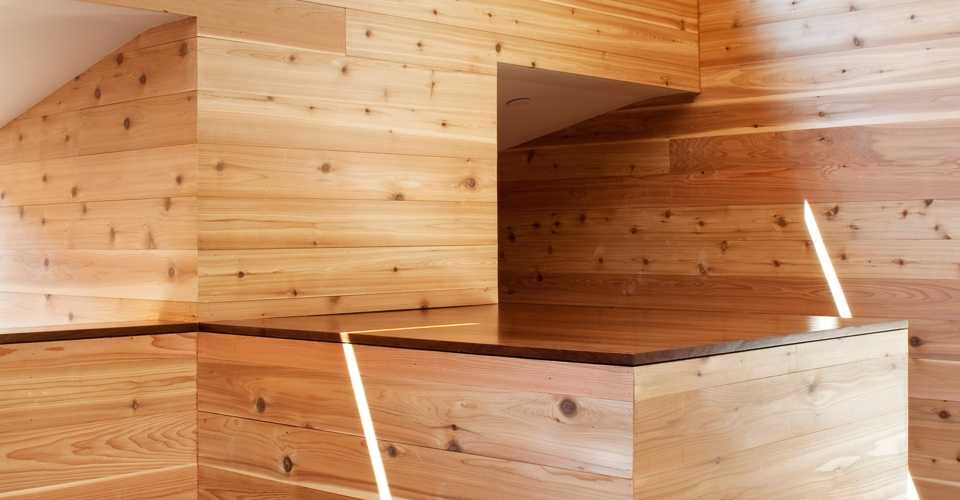Back
Back
Back
Back
Back
Back
Back
Back
Back
Back
Back
Back
Back
Back
Back
Back
Back
Back
Back
Back
Back
Back
Back
Back
Back
New Zealand
Western Red Cedar Engineering Data


Section Properties
Section properties are used in various design calculations. For convenience, the following are formulas to calculate the section properties of rectangular beam cross sections.
Definitions
Neutral axis, in the cross section of a beam, is the line in which there is neither tension nor compression stress.
Moment of Inertia (I) of the cross section of beam is the sum of Table the products of each of its elementary areas multiplied by the square of their distance from the neutral axis of the section.
Section Modulus (S) is the moment of inertia divided by the distance from the neutral axis to the extreme fiber of the section.
Cross Section is a section taken through the member perpendicular to its longitudinal axis.
Formulas
The following symbols and formulas apply to rectangular beam cross sections:
X-X= neutral axis for edgewise bending (load applied to narrow face)
Y-Y= Neutral axis for flatwise bending (load applied to narrow face)
b= breadth of rectangular bending member(in.)
d= depth of rectangular bending member (in.)
A= bd=area of cross section (in.2)
c= distance from neutral axis to extreme fiber of cross section (in.)
Ixx= bd3/12 = moment of inertia about the X-X axis (in.4)
Iyy= db3/12 = moment of inertia about the Y-Y axis (in.4)
rxx= Square root of (Ixx/A) = d/Square root of 12 = radius of gyration about the X-X axis (in.)
ryy= Square root of (Iyy/A) = b/Square root of 12 = radius of gyration about the Y-Y axis (in.)
sxx= Ixx /c = bd2/6 = section modulus about the X-X axis (in.3)
syy= Iyy /c = db2/6 = section modulus about the Y-Y axis (in.3)
Sizes of rough and dressed Western Red Cedar are shown in Tables 1 and 2.
Span Tables
Spans for Western Red Cedar dimension lumber used as joists and rafters in residential and commercial structures are available from the Western Red Cedar Lumber Association, the Canadian Wood Council and the National Association of Home Builders. Please request publication The U.S Span Book for Canadian Lumber. Cost $10.
Table 1. Sizes of Rough Western Red Cedar
| Thickness (in.) | 1 | 1-3/4 | 2 | 3 | 4 | 6 | 8 | 10 | 12 | 14 |
|---|---|---|---|---|---|---|---|---|---|---|
| Width (in.) | 2 | 4 | 6 | 8 | 10 | 12 | 14 | – | – | – |
Table 2. Sizes of Dressed Western Red Cedar
| Item | Thickness (in.) | Width (in.) | ||||
|---|---|---|---|---|---|---|
| Actual | Actual | |||||
| Nominal | Dry | Green | Nominal | Dry | Green | |
| Boards | 1 | 11/16 | 3/4 | 2 | 1-1/2 | 1/9/16 |
| 1-1/4 | 1 | 1-1/32 | 3 | 2-1/2 | 2-9/16 | |
| 4 | 3-1/2 | 3-9/16 | ||||
| 6 | 5-1/2 | 5-9/16 | ||||
| 8 | 7-1/2 | 7-3/8 | ||||
| 10 | 9-1/4 | 9-3/8 | ||||
| 12 | 11-1/4 | 11-3/8 | ||||
| Garden Lumber | 2 | 1-1/2 | 1-9/16 | 2 | 1-1/2 | 1-9/16 |
| 3 | 2-1/2 | 2-9/16 | 3 | 2-1/2 | 2-9/16 | |
| 4 | 3-1/2 | 3-9/16 | 4 | 3-1/2 | 3-9/16 | |
| 6 | 5-1/2 | 5-9/16 | ||||
| 8 | 7-1/4 | 7-3/8 | ||||
| 10 | 9-1/4 | 9-3/8 | ||||
| 12 | 11-1/4 | 11-3/8 | ||||
| Timbers* | 5 | 4-1/2 | 5 | 4-1/2 | ||
| 6 | 5-1/2 | 6 | 5-1/2 | |||
| 8 | 7-1/2 | 8 | 7-1/2 | |||
*Surfaced timbers 10″ and larger available only on special order. Confirm before specifying.
Siding Coverage
Table 3. Coverage of Western Red Cedar Cladding
To obtain the coverage of a specified width of cladding from Table 3, perform the following calculations:
- Calculate total wall area (length x height).
- Subtract square footage of openings (windows, doors) to determine wall area for cladding.
- Add 10% for trim loss.
- Multiply figure by the appropriate factor from the table for linear or board feet.
Example:
- Length x height = 160 square feet
- Door = 20 square feet
Window = 20 square feet
Area for cladding = 120 square feet - Add 10% for trim loss= 120 + 12 = 132 square feet
- Assuming 6 inch cladding
132 x 2.67 = 357.4 linear feet
132 x 1.33 = 175.6 board feet
| Cladding Type | Nominal Width (in.) | Dressed Width (in.) | Exposed Face Width (in.) | Linear Feet Factor | Board Feet Factor |
|---|---|---|---|---|---|
| Bevel Cladding1 | 4 6 8 10 12 | 3-1/2 5-1/2 7-1/2 9-1/2 11-1/2 | 2-1/2 4-1/2 6-1/2 8-1/2 10-1/2 | 4.80 2.67 1.85 1.41 1.14 | 1.60 1.33 1.23 1.18 1.14 |
| Tongue and Groove Cladding | 4 6 8 | 3-3/8 5-3/8 7-3/8 | 3 5 6-3/4 | 4.00 2.40 1.77 | 1.33 1.20 1.19 |
| Channel Cladding | 6 8 10 | 5-1/2 7-3/8 9-3/8 | 4-3/4 6-5/8 8-5/8 | 2.53 1.81 1.39 | 1.27 1.21 1.16 |
| Board and Batten Cladding | 2 4 6 8 10 12 | 1-9/16 3-9/16 5-9/16 7-3/8 9-3/8 11-3/8 | varies with width of board | see footnote 2 | |
Notes:
- Assuming minimum 1″ overlaps. Larger overlaps can be used, particularly on wider claddings such as 10″ and 12″ pieces.
- Linear Feet Factor = Exposed Face Width/12.
Board Feet Factor = Nominal Width/Exposed Face Width.
Base Design Values
Base Design Values (United States Only)
Since different sizes of visually-graded lumber have different values, the design values shown in Table 4 are tabulated in a base value approach. Base values are provided for a base size that depends on the grade. For Select Structural, No.1, No.2 and No.3 grades, the base strength values are published on a 2×12 basis. For Construction Standard and Utility grades, the base strength values are published on a 2×4 basis (the size factor is always 1.0). For Stud grade, the base strength values are published on a 2×6 basis. These values are for use in the United States only.
To determine the value for a given size, the designer selects a base value for a given grade then multiplies the base value by a size factor from Table 5.
The base design values apply to Western Red Cedar manufactured by members of the Western Red Cedar Lumber Association and graded to National Lumber Grading Authority (NLGA), West Coast Lumber Inspection Bureau (WCLIB) or Western Wood Products Association (WWPA) rules. Grades and sizes of Canadian dimension lumber are identical to those in use throughout the United States and conform to the requirements of applicable American Standards.
Table 4. Base Design Values for Use in the USA for Visually Graded (WCLIB, WWPA) Western Red Cedar 2-4″ Thick x 2″ and Wider
Base values in pounds per square inch (psi) – Use with Adjustment Factors (see Tables 5 to 9)
| Grade | Extreme Fiber Stress in Bending Fb | Tension Parallel to Grain F1 | Horizontal Shear Fv | Compression | Modulus of Elasticity (million psi) E | |
|---|---|---|---|---|---|---|
| Perpndcular. to Grain Fc(perp) | Parallel to Grain Fc | |||||
| Select Structural No.1/No.2 No.3 | 1000 725 / 700 400 | 600 425 / 425 250 | 155 155 155 | 425 425 425 | 1,000 825 / 650 375 | 1.1 1.0 / 1.0 0.9 |
| Construction Standard Utility | 800 450 225 | 475 275 125 | 155 155 155 | 425 425 425 | 850 650 425 | 0.9 0.8 0.8 |
| Stud | 550 | 325 | 155 | 425 | 400 | 0.9 |
Notes:
- No. 1/No. 2 applies to either No. 1 or No. 2 grades.
- Values for Utility grade apply only to 2″x4″ lumber.
- For studs wider than 6″ bearing the “Stud” grademark, use the property values and size factors for No. 3 grade.
Table 5. Size Factors (CF) for Tabulated Design Values
| Grades | Nominal Width (depth in in.) | Fb less than 4″ thick | Fb 4″ thick nominal | Ft | Fc | Other Properties |
|---|---|---|---|---|---|---|
| Select Structural No.1 No.2 No.3 | 4 & less 5 6 8 10 12 14 & wider | 1.5 1.4 1.3 1.2 1.1 1.0 0.9 | 1.5 1.4 1.3 1.3 1.2 1.1 1.0 | 1.5 1.4 1.3 1.2 1.1 1.0 0.9 | 1.15 1.1 1.1 1.05 1.0 1.0 0.9 | 1.0 1.0 1.0 1.0 1.0 1.0 1.0 |
| Construction & Standard | 4 & less | 1.0 | 1.0 | 1.0 | 1.0 | 1.0 |
| Utility | 4 | 1.0 | 1.0 | 1.0 | 1.0 | 1.0 |
| Stud* | 4 & less 5 & 6 | 1.1 1.0 | 1.1 1.0 | 1.1 1.0 | 1.05 1.0 | 1.0 1.0 |
| MSR and plank Decking All grades & sizes | 1.0 | 1.0 | – | 1.0 | 1.0 | 1.0 |
*Factors are for Stud grade widths 6″ and less. For studs wider than 6″, use the design values and size factors for No. 3 grade.
Table 6. Wet Use Factors (CM) for Tabulated Design Values
The recommended design values are for applications where the moisture content of the wood does not exceed 19%. For use conditions where the moisture content of dimension lumber will exceed 19%, the Wet Use Adjustment Factors below are recommended.
| Property | Adjustment Factor |
|---|---|
| Fb Extreme Fiber Stress in Bending | 0.85* |
| Ft Tension Parallel to Grain | 1.0 |
| Fc Compression Parellel to Grain | 0.8** |
| Fv Horizontal Shear | 0.97 |
| Fc1 Compression Perpendicular to Grain | 0.67 |
| E Modulus of Elasticity | 0.9 |
Notes:
* Bending Wet Use Factor = 1.0 where Fb CF
(Base Value x Size Factor) does not exceed 1,150 psi.
** Compression Parallel Wet Use Factor=1.0 where Fc CF
(Base Value x Size Factor) does not exceed 750 psi.
Table 7. Flat Use Factors (Cfu)
Apply to Tabulated Design Values for Extreme Fiber Stress in Bending Where Lumber is used Flatwise Rather than on Edge.
| Nominal Width (in.) | Nominal Thickness (in.) | |
|---|---|---|
| Less than 4 | 4 | |
| Less than 4 | 1.00 | – |
| 4 | 1.10 | 1.00 |
| 5 | 1.10 | 1.05 |
| 6 | 1.15 | 1.05 |
| 8 | 1.15 | 1.05 |
| 10 & Wider | 1.20 | 1.10 |
Note: These factors apply to all dimension lumber except tongue-and-grove decking grades. For T & G decking, the following adjustments may be used:
| Nominal thickness | 2″ | 3″ | 4″ |
| Flat use factor | 1.10 | 1.04 | 1.00 |
Table 8. Repetitive Member Factor (Cr)
Applies to Tabulated Design Values for Extreme Fiber Stress in Bending when members are used as joists, truss chords, rafters, studs, planks, decking or similar members which are in contact or spaced not more than 24″ on centers, are not less than 3 in number and are joined by floor, roof or other load distributing elements adequate to support the design load.
| 1.5 |
Table 9. Duration of Load Adjustment (CD) For Tabulated Design Values
| Load Duration | Factor |
|---|---|
| Permanent | 0.9 |
| Ten Years (normal load) | 1.0 |
| Two Months (snow load) | 1.15 |
| Seven Days | 1.25 |
| Ten Minutes (wind, earthquake) | 1.6 |
| Impact | 2.0 |
Note: Confirm load requirements with local codes. Refer to Model Building Codes or the National Design Specification for high-temperature or fire-retardant treated adjustment factors.
Table 10. Horizontal Shear Adjustment For Tabulated Design Values (CH)
All horizontal shear base values are established as if a piece were split full length and as such the values are reduced from those permitted to be assigned in accordance with ASTM standards. This reduction is made to compensate for any degree of shake, check or split that might develop in a piece.
| 2 in. Thick (Nominal) Lumber | 3 in. and Thicker (Nominal) Lumber | ||
|---|---|---|---|
| For convenience, the table below may be used to determine horizontal shear values for any grade of 2″ thick lumber in any species when the length of split or check is known: | Horizontal shear values for 3″ and thicker lumber also are established as if a piece were split full length. When specific lengths of splits are known and any increase in them is not anticipated, the following adjustments may be applied: | ||
| When length of split on wide face does not exceed: | Multiply tabulated Fv value by: | When length of split on wide face does not exceed | Multiply tabulated Fv value by: |
| No split 1/2 x wide face 3/4 x wide face 1 x wide face 1-1/2 x wide face or more | 2.00 1.67 1.50 1.33 1.00 | No split 1/2 x narrow face1 x narrow face 1-1/2 x narrow face or more | 2.00 1.671.33 1.00 |
Table 11. Adjustments for Compression Perpendicular to Grain To Deformation Basis of 0.02″
Design values for compression perpendicular to grain are established in accordance with the procedures set forth in ASTM D 2555 and D 245. ASTM procedures consider deformation under bearing loads as a serviceability limit state comparable to bending deflection because bearing loads rarely cause structural failures. Therefore, ASTM procedures for determining compression perpendicular to grain values are based on a deformation of 0.04″ and are considered adequate for most classes of structures. Where more stringent measures need be taken in design, the following permits the designer to adjust design values to a more conservative deformation basis of 0.02″.
| Y02 = 0.73Y04 + 5.60 |
Table 12. Design Values for Use in the USA for Visually Graded (WCLIB, WWPA)Western Red Cedar Timbers 5″ X 5″ and Larger
| Design values in pounds per square inch (psi) | |||||||
|---|---|---|---|---|---|---|---|
| Size Grade | Classification | Extreme Fiber Stress in Bending Fb | Tension Parallel to Grain F1 | Shear Parallel to Grain Fv | Compression Perpendicular to Grain Fc | Compression Parallel to Grain Fc | Modulus of Elasticity E |
| Select Structural No. 1 No. 2 | Beams and Stringers | 1,150 975 625 | 675 475 325 | 140 140 140 | 425 425 425 | 875 725 475 | 1,000,000 1,000,000 800,000 |
| Select Structural No. 1 No. 2 | Posts and Timber | 1,100 875 550 | 725 600 350 | 140 140 140 | 425 425 425 | 925 800 550 | 1,000,000 1,000,000 800,000 |
Please note that the measurements displayed on this webpage are displayed in Imperial units. If metric is required, please perform the proper conversion as necessary.
Please note that the standards, grades and other information mentioned on this webpage are based on North American data. Please refer to your local resources or authorities for country-specific data relating to a particular country if required.
© 2025 All rights reserved
Gatsby Website Development by Jambaree


